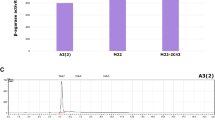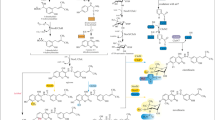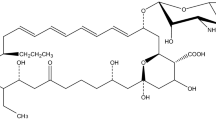Abstract
Bacterial prodigiosins are red-colored secondary metabolites with multiple activities, such as anticancer, antimalarial and immunosuppressive, which hold great potential for medical applications. In this study, dramatically enhanced prodigiosins (RED) production in Streptomyces coelicolor was achieved by combinatorial metabolic engineering, including inactivation of the repressor gene ohkA, deletion of the actinorhodin (ACT) and calcium-dependent antibiotic (CDA) biosynthetic gene clusters (BGCs) and multi-copy chromosomal integration of the RED BGC. The results showed that ohkA deletion led to a 1-fold increase of RED production over the wild-type strain M145. Then, the ACT and CDA BGCs were deleted successively based on the ΔohkA mutant (SBJ101). To achieve multi-copy RED BGC integration, artificial ΦC31 attB site(s) were inserted simultaneously at the position where the ACT and CDA BGCs were deleted. The resulting strains SBJ102 (with a single deletion of the ACT BGC and insertion of one artificial attB site) and SBJ103 (with the deletion of both BGCs and insertion of two artificial attB sites) produced 1.9- and 6-fold higher RED titers than M145, respectively. Finally, the entire RED BGC was introduced into mutants from SBJ101 to SBJ103, generating three mutants (from SBJ104 to SBJ106) with chromosomal integration of one to three copies of the RED BGC. The highest RED yield was from SBJ106, which produced a maximum level of 96.8 mg g−1 cell dry weight, showing a 12-fold increase relative to M145. Collectively, the metabolic engineering strategies employed in this study are very efficient for the construction of high prodigiosin-producing strains.
Similar content being viewed by others
References
Anderson, T.B., Brian, P., and Champness, W.C. (2001). Genetic and transcriptional analysis of absA, an antibiotic gene cluster-linked two-component system that regulates multiple antibiotics in Streptomyces coelicolor. Mol Microbiol 39, 553–566.
Chang, C.C., Chen, W.C., Ho, T.F., Wu, H.S., and Wei, Y.H. (2011). Development of natural anti-tumor drugs by microorganisms. J Biosci Bioeng 111, 501–511.
Darshan, N., and Manonmani, H.K. (2015). Prodigiosin and its potential applications. J Food Sci Technol 52, 5393–5407.
de Araújo, H.W., Fukushima, K., and Takaki, G.M. (2010). Prodigiosin production by Serratia marcescens UCP 1549 using renewable-resources as a low cost substrate. Molecules 15, 6931–6940.
Gibson, D.G., Young, L., Chuang, R.Y., Venter, J.C., Hutchison, C.A., and Smith, H.O. (2009). Enzymatic assembly of DNA molecules up to several hundred kilobases. Nat Meth 6, 343–345.
Giri, A.V., Anandkumar, N., Muthukumaran, G., and Pennathur, G. (2004). A novel medium for the enhanced cell growth and production of prodigiosin from Serratia marcescens isolated from soil. BMC Microbiol 4, 11.
Gust, B., Challis, G.L., Fowler, K., Kieser, T., and Chater, K.F. (2003). PCR-targeted Streptomyces gene replacement identifies a protein domain needed for biosynthesis of the sesquiterpene soil odor geosmin. Proc Natl Acad Sci USA 100, 1541–1546.
Guthrie, E.P., Flaxman, C.S., White, J., Hodgson, D.A., Bibb, M.J., and Chater, K.F. (1998). A response-regulator-like activator of antibiotic synthesis from Streptomyces coelicolor A3(2) with an amino-terminal domain that lacks a phosphorylation pocket. Microbiology 144 (Pt 3), 727–738.
Hejazi, A., and Falkiner, F.R. (1997). Serratia marcescens. J Med Microbiol 46, 903–912.
Huang, H., Zheng, G., Jiang, W., Hu, H., and Lu, Y. (2015). One-step high-efficiency CRISPR/Cas9-mediated genome editing in Streptomyces. Acta Biochim Biophys Sin (Shanghai) 47, 231–243.
Kieser, T., Bibb M., Buttner M., and Chater K. (2000). Practical Streptomyces genetics. John Innes Foundation, Norwich, England.
Lee, N.C.O., Larionov, V., and Kouprina, N. (2015). Highly efficient CRISPR/Cas9-mediated TAR cloning of genes and chromosomal loci from complex genomes in yeast. Nucleic Acids Res 43, e55–e55.
Li, L., Zheng, G., Chen, J., Ge, M., Jiang, W., and Lu, Y. (2017). Multiplexed site-specific genome engineering for overproducing bioactive secondary metabolites in actinomycetes. Metab Eng 40, 80–92.
Liu, G., Chater, K.F., Chandra, G., Niu, G., and Tan, H. (2013). Molecular regulation of antibiotic biosynthesis in Streptomyces. Microbiol Mol Biol Rev 77, 112–143.
Livak, K.J., and Schmittgen, T.D. (2001). Analysis of relative gene expression data using real-time quantitative PCR and the 2-CT method. Methods 25, 402–408.
Lu, C., Zhang, X., Jiang, M., and Bai, L. (2016). Enhanced salinomycin production by adjusting the supply of polyketide extender units in Streptomyces albus. Metab Eng 35, 129–137.
Lu, Y., He, J., Zhu, H., Yu, Z., Wang, R., Chen, Y., Dang, F., Zhang, W., Yang, S., and Jiang, W. (2011). An orphan histidine kinase, OhkA, regulates both secondary metabolism and morphological differentiation in Streptomyces coelicolor. J Bacteriol 193, 3020–3032.
Mahlen, S.D. (2011). Serratia infections: from military experiments to current practice. Clin Microbiol Rev 24, 755–791.
Mao, X.M., Sun, Z.H., Liang, B.R., Wang, Z.B., Feng, W.H., Huang, F.L., and Li, Y.Q. (2013). Positive feedback regulation of stgR expression for secondary metabolism in Streptomyces coelicolor. J Bacteriol 195, 2072–2078.
Mo, S.J., Kim, J., and Oh, C.H. (2013). Different effects of acidic pH shock on the prodiginine production in Streptomyces coelicolor M511 and SJM1 mutants. J Microbiol Biotechnol 23, 1454–1459.
Mo, S.J., Sydor, P.K., Corre, C., Alhamadsheh, M.M., Stanley, A.E., Haynes, S.W., Song, L., Reynolds, K.A., and Challis, G.L. (2008). Elucidation of the Streptomyces coelicolor pathway to 2-undecylpyrrole, a key intermediate in undecylprodiginine and streptorubin B biosynthesis. Chem Biol 15, 137–148.
Morgenstern, A., Paetz, C., Behrend, A., and Spiteller, D. (2015). Divalent transition-metal-ion stress induces prodigiosin biosynthesis inStreptomyces coelicolor M145: formation of coeligiosins. Chem Eur J 21, 6027–6032.
Ou, X., Zhang, B., Zhang, L., Zhao, G., and Ding, X. (2009). Characterization of rrdA, a TetR family protein gene involved in the regulation of secondary metabolism in Streptomyces coelicolor. Appl Environ Microbiol 75, 2158–2165.
Schäberle, T.F., Orland, A., and König, G.M. (2014). Enhanced production of undecylprodigiosin in Streptomyces coelicolor by co-cultivation with the corallopyronin A-producing myxobacterium, Corallococcus coralloides. Biotechnol Lett 36, 641–648.
Sevcikova, B., and Kormanec, J. (2004). Differential production of two antibiotics of Streptomyces coelicolor A3(2), actinorhodin and undecylprodigiosin, upon salt stress conditions. Arch Microbiol 181, 384–389.
Stankovic, N., Senerovic, L., Ilic-Tomic, T., Vasiljevic, B., and Nikodinovic-Runic, J. (2014). Properties and applications of undecylprodigiosin and other bacterial prodigiosins. Appl Microbiol Biotechnol 98, 3841–3858.
Stanley, A.E., Walton, L.J., Kourdi Zerikly, M., Corre, C., and Challis, G.L. (2006). Elucidation of the Streptomyces coelicolor pathway to 4-methoxy-2,2’-bipyrrole-5-carboxaldehyde, an intermediate in prodiginine biosynthesis. Chem Commun (Camb), 3981–3983.
Swiatek, M.A., Gubbens, J., Bucca, G., Song, E., Yang, Y.H., Laing, E., Kim, B.G., Smith, C.P., and van Wezel, G.P. (2013). The ROK family regulator Rok7B7 pleiotropically affects xylose utilization, carbon catabolite repression, and antibiotic production in Streptomyces coelicolor. J Bacteriol 195, 1236–1248.
Swiatek, M.A., Tenconi, E., Rigali, S., and van Wezel, G.P. (2012). Functional analysis of the N-acetylglucosamine metabolic genes of Streptomyces coelicolor and role in control of development and antibiotic production. J Bacteriol 194, 1136–1144.
Takano, E., Gramajo, H.C., Strauch, E., Andres, N., White, J., and Bibb, M.J. (1992). Transcriptional regulation of the redD transcriptional activator gene accounts for growth-phase-dependent production of the antibiotic undecylprodigiosin in Streptomyces coelicolor A3(2). Mol Microbiol 6, 2797–2804.
Tsao, S.W., Rudd, B.A.M., He, X.G., Chang, C.J., and Floss, H.G. (1985). Identification of a red pigment from Streptomyces coelicolor A3(2) as a mixture of prodigiosin derivatives.. J Antibiot 38, 128–131.
van Dissel, D., Claessen, D., Roth, M., and van Wezel, G.P. (2015). A novel locus for mycelial aggregation forms a gateway to improved Streptomyces cell factories. Microb Cell Fact 14, 44.
Wang, R., Mast, Y., Wang, J., Zhang, W., Zhao, G., Wohlleben, W., Lu, Y., and Jiang, W. (2013). Identification of two-component system AfsQ1/Q2 regulon and its cross-regulation with GlnR in Streptomyces coelicolor. Mol Microbiol 87, 30–48.
Wei, Y.H., and Chen, W.C. (2005). Enhanced production of prodigiosin-like pigment from Serratia marcescens SM?R by medium improvement and oil-supplementation strategies. J Biosci Bioeng 99, 616–622.
Williamson, N.R., Fineran, P.C., Leeper, F.J., and Salmond, G.P.C. (2006). The biosynthesis and regulation of bacterial prodiginines. Nat Rev Microbiol 4, 887–899.
Williamson, N.R., Simonsen, H.T., Ahmed, R.A.A., Goldet, G., Slater, H., Woodley, L., Leeper, F.J., and Salmond, G.P.C. (2005). Biosynthesis of the red antibiotic, prodigiosin, in Serratia: identification of a novel 2-methyl-3-n-amyl-pyrrole (MAP) assembly pathway, definition of the terminal condensing enzyme, and implications for undecylprodigiosin biosynthesis in Streptomyces. Mol Microbiol 56, 971–989.
Yamanaka, K., Reynolds, K.A., Kersten, R.D., Ryan, K.S., Gonzalez, D.J., Nizet, V., Dorrestein, P.C., and Moore, B.S. (2014). Direct cloning and refactoring of a silent lipopeptide biosynthetic gene cluster yields the antibiotic taromycin A. Proc Natl Acad Sci USA 111, 1957–1962.
Yu, Z., Zhu, H., Dang, F., Zhang, W., Qin, Z., Yang, S., Tan, H., Lu, Y., and Jiang, W. (2012). Differential regulation of antibiotic biosynthesis by DraR-K, a novel two-component system in Streptomyces coelicolor. Mol Microbiol 85, 535–556.
Zhang, B., Zhang, L., Dai, R., Yu, M., Zhao, G., and Ding, X. (2013). An efficient procedure for marker-free mutagenesis of S.coelicolor by sitespecific recombination for secondary metabolite overproduction. PLoS ONE 8, e55906.
Acknowledgements
This work was supported by the National Natural Science Foundation of China (31430004, 31421061, 31630003, 31370081 and 31570072) and the Science and Technology Commission of Shanghai Municipality (16490712100).
Author information
Authors and Affiliations
Corresponding author
Rights and permissions
About this article
Cite this article
Liu, P., Zhu, H., Zheng, G. et al. Metabolic engineering of Streptomyces coelicolor for enhanced prodigiosins (RED) production. Sci. China Life Sci. 60, 948–957 (2017). https://doi.org/10.1007/s11427-017-9117-x
Received:
Accepted:
Published:
Issue Date:
DOI: https://doi.org/10.1007/s11427-017-9117-x




